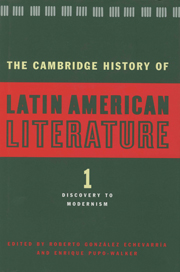Book contents
- Frontmatter
- Introduction to Volume 1
- 1 A brief history of the history of Spanish American Literature
- 2 Cultures in contact: Mesoamerica, the Andes, and the European written tradition
- 3 The first fifty years of Hispanic New World historiography: the Caribbean, Mexico, and Central America
- 4 Historians of the conquest and colonization of the New World: 1550–1620
- 5 Historians of the colonial period: 1620–1700
- 6 Colonial lyric
- 7 Epic poetry
- 8 Spanish American theatre of the colonial period
- 9 Viceregal culture
- 10 The eighteenth century: narrative forms, scholarship, and learning
- 11 Lyric poetry of the eighteenth and nineteenth centuries
- 12 Spanish American theatre of the eighteenth century
- 13 The nineteenth-century Spanish American novel
- 14 The brief narrative in Spanish America: 1835–1915
- 15 The Spanish American theatre of the nineteenth century
- 16 The essay in Spanish South America: 1800 to Modernismo
- 17 The essay of nineteenth-century Mexico, Central America, and the Caribbean
- 18 The gaucho genre
- Index
- Bibliographies
- References
15 - The Spanish American theatre of the nineteenth century
Published online by Cambridge University Press: 28 March 2008
- Frontmatter
- Introduction to Volume 1
- 1 A brief history of the history of Spanish American Literature
- 2 Cultures in contact: Mesoamerica, the Andes, and the European written tradition
- 3 The first fifty years of Hispanic New World historiography: the Caribbean, Mexico, and Central America
- 4 Historians of the conquest and colonization of the New World: 1550–1620
- 5 Historians of the colonial period: 1620–1700
- 6 Colonial lyric
- 7 Epic poetry
- 8 Spanish American theatre of the colonial period
- 9 Viceregal culture
- 10 The eighteenth century: narrative forms, scholarship, and learning
- 11 Lyric poetry of the eighteenth and nineteenth centuries
- 12 Spanish American theatre of the eighteenth century
- 13 The nineteenth-century Spanish American novel
- 14 The brief narrative in Spanish America: 1835–1915
- 15 The Spanish American theatre of the nineteenth century
- 16 The essay in Spanish South America: 1800 to Modernismo
- 17 The essay of nineteenth-century Mexico, Central America, and the Caribbean
- 18 The gaucho genre
- Index
- Bibliographies
- References
Summary
Theatre in Spanish America in the nineteenth century was limited to a few larger cities. Neoclassicism was dominant until about 1810; thereafter the dominant aesthetic was essentially romantic, although often disguised by forms borrowed from other schools. While European Romanticism disappeared after mid century, the Spanish American version is more long lasting, and is closely related to two developments which span the late nineteenth and early twentieth centuries: Costumbrismo, the depiction of regional customs which is often a mask for growing nationalism, and a popularly based urban theatre. Traditional terms such as Neoclassicism, Romanticism, post-Romanticism, or Modernism are misleading, for these trends often coexist and are profoundly influenced by romantic attitudes. These complexities and the difficulties involved in treating jointly a number of national literatures make the historiography of Spanish American letters a complicated and often polemical undertaking on which there is no broad agreement. For purposes of convenience, the organization used here is that developed by José Juan Arrom, which follows a generational scheme based on a thirty-year pattern. This deals adequately with literary change and development overall if applied with flexibility allowing for the considerable variations within individual nations and each generation.
The Generation of 1804
Although it includes the movement for political independence, the Generation of 1804, born between 1774 and 1804, is a transitional movement, a tie to the past rather than a rupture with the status quo. There were no profound socio-economic changes, despite political chaos, and the period tends toward the retention of forms and ideas inherited from the preceding generation.
- Type
- Chapter
- Information
- The Cambridge History of Latin American Literature , pp. 536 - 555Publisher: Cambridge University PressPrint publication year: 1996
References
- 1
- Cited by



